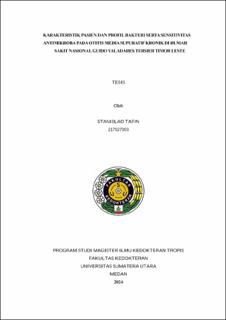Karakteristik Pasien dan Profil Bakteri serta Sensitivitas Antimikroba pada Otitis Media Supuratif Kronik di Rumah Sakit Nasional Guido Valadares Tersier Timor Leste
Patient Characteristics and Bacterial Profile and Antimicrobial Sensitivity in Chronic Suppurative Otitis Media at The National Hospital Guido Valadares Tertiary Timor Leste

Date
2024Author
Tafin, Stanislao
Advisor(s)
Adriztina, Indri
Kusumawati, R Lia
Metadata
Show full item recordAbstract
Chronic Suppurative Otitis Media (CSOM) is still a clinically significant public health problem. Many antibiotic-resistant bacteria are now found in CSOM patients. This condition will support the development of bacteria so that it can
cause complications. Aims to determine the distribution of patient characteristics and bacterial profil and antimicrobial sensitivity in CSOM at the Guido Valadares Tertiary National Hospital in Timor Leste.
This study, an observational analytical with cross-sectional approach was carried
out at the Guido Valadares Tertiary National Hospital in Timor Leste in April-
June 2024. The technique for collecting medical record data from CSOM patients
used was purposive sampling with inclusion criteria. Bacterial identification was carried out using by microscope (Gram Staining), oxidase and catalase tests, and Bruker Microflex Maldi TOF MS with of the middle ear secretion swab sample.
Identification of bacterial species was performed by antimicrobial sensitivity testing using BD Phoenix according to EUCAST. Data process with SPSS version 26 software. Data analysis used was univariate analysis and chi-square test. The level of significance p < 0.05 with a 95% confidence interval.
From a total of 108 medical record data of CSOM patients, patient characteristics were found, the majority of the age group under 10 years (48.1%), the most male 66.7%, as many as (90.7%) benign CSOM type that are often infected, the most
common main complaint is ear discharge (91.7%), the most duration of pain complaints is 0-5 years (87.0%) and the most infected ear is the left ear (77.8%). From 128 total of bacterial profil. It was found, (70.31%) Gram-negative bacteria are the most common cause of CSOM, followed by Gram-positive bacteria (29.69%). Meanwhile, the growth of monomicrobial (82.41%) and polymicrobial (17.59%). Pseudomonas aeruginosa (39.84%), the most common cause found in
CSOM and followed by Staphylococcus aureus (13.28%). Antimicrobial sensitivity was found, Pseudomonas aeruginosa was sensitive to amikacin and meropenem
(98.04%) and high resistency to ceftrixone (100%). While, Staphylococcus aureus was sensitive to cefazolin, cefalexin, clindamycin, erythromycin and vancomycin
(88.24%), and high resistency to the penicillin (100%). This study Pseudomonas aeruginosa was the most common bacteria found in CSOM patient.
